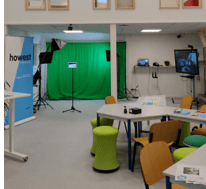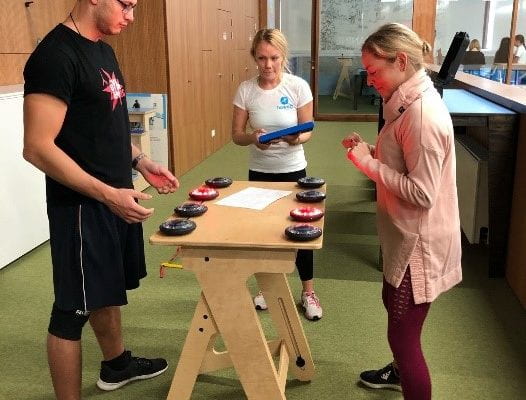Student Reflection on planning our project in Bruges
In October of last year, myself and eight others from the UK travelled to Bruges, Belgium, as part of a group of 50 participants who met to plan what we would be doing for DLAB during the year.
For most of the week we were based at Howest University campus in Bruges, where we explored a range of technologies. The first two days of the week focused on sharing technologies and ways in which they can be used in education. Lecturers from each country ran workshops and we had the opportunity to use VR headsets, greenscreens, 360 cameras and merge cubes, which can be used with AR.
 Howest has some brilliant tech facilities and in their Education Hub – pictured right – we were able to explore Google Earth using the VR headsets. Google Earth has a new function which enables you to view popular destinations with 3D renditions and ‘fly over’ the locations. I had the opportunity to explore Rio de Janeiro and view the city from the position of Christ the Redeemer, all enabled by VR.
Howest has some brilliant tech facilities and in their Education Hub – pictured right – we were able to explore Google Earth using the VR headsets. Google Earth has a new function which enables you to view popular destinations with 3D renditions and ‘fly over’ the locations. I had the opportunity to explore Rio de Janeiro and view the city from the position of Christ the Redeemer, all enabled by VR.
 We also visited the Sports Innovation campus in Bruges, where we were introduced to the concept of ‘exergaming’, which involved using games to promote physical activity and exercise. We explored a range of technology, including Makey Makey and programmable equipment which support agility training. A personal favourite of these was FitLight – technology involving motion activated light-up disks which can be programmed using a tablet and are particularly popular for speed and agility training. The tech we explored at the Sports Innovation campus provided a lot of the inspiration for the activities we led in school.
We also visited the Sports Innovation campus in Bruges, where we were introduced to the concept of ‘exergaming’, which involved using games to promote physical activity and exercise. We explored a range of technology, including Makey Makey and programmable equipment which support agility training. A personal favourite of these was FitLight – technology involving motion activated light-up disks which can be programmed using a tablet and are particularly popular for speed and agility training. The tech we explored at the Sports Innovation campus provided a lot of the inspiration for the activities we led in school.
Later in the week, we also had had a VR swimming experience. Using VR headsets, which showed scenes of swimming through the ocean, we were floating in a swimming pool, adding a whole other level of immersion. It was an experience I would highly recommend if given the chance!
 Now, the purpose of this week was not only to explore these technologies but also plan the international days we would run in schools throughout the rest of the year. We were split into four groups with a mixture of lecturers, teachers and students from the countries in the project. My group worked in partnership with lecturers, teachers and students from Denmark, to determine the focus of our group’s strand of the project – which was exergaming – and plan specific activities we would do with the children in school.
Now, the purpose of this week was not only to explore these technologies but also plan the international days we would run in schools throughout the rest of the year. We were split into four groups with a mixture of lecturers, teachers and students from the countries in the project. My group worked in partnership with lecturers, teachers and students from Denmark, to determine the focus of our group’s strand of the project – which was exergaming – and plan specific activities we would do with the children in school.
Something we were keen to include was opportunities for our children to communicate with the children in Denmark, which we were able to do using video calls and Twitter. Our live Twitter feed would enable the children to keep track of what their Danish counterparts had been up to throughout the day – we had used a similar TweetBeam whilst in Bruges. By the end of the week in Bruges, my group had planned three international days that would allow the children from Denmark and England to work synchronously on an exergaming challenge. We looked forward to taking our work into schools and introducing the children to the technology and exergaming.
The week in Bruges was the first time I had ever worked on such a project, with international partners and such an interesting range of technology. The Belgium team organised a fantastic programme which provided us with a myriad of opportunities to explore tech and engage in activities which enabled us to both view Bruges and follow the theme of physical boundaries. The concept of exergaming is one that I had been unconsciously aware of throughout my childhood and adolescence, where technology such as Nintendo WiiFit and apps like Pokémon Go had become increasingly popular. However, the week in Bruges introduced me to more accessible technology which could be used in the everyday classroom.
Beth Garrett, University of Northampton


